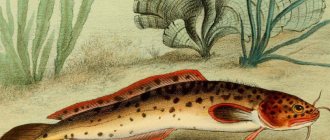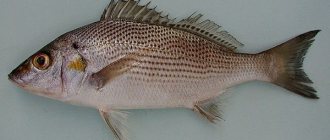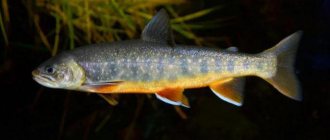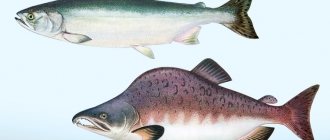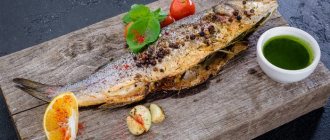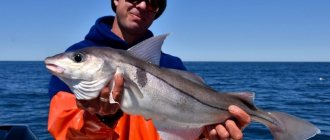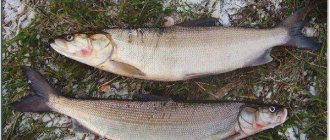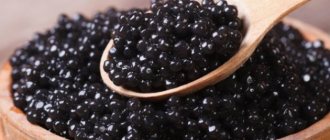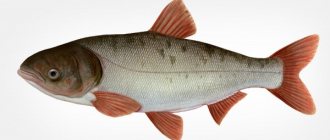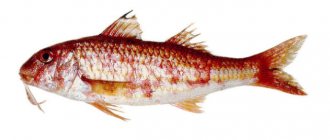Pink salmon is one of the representatives of the salmon family. The fish is found in cold waters of the Pacific and Arctic oceans. It is caught off the coast of California, Sakhalin, the Commander and Kuril Islands, in the Bering and Okhotsk Seas. Pink salmon are not grown in artificial ponds. The fish lives in salt waters and goes to fresh lakes and rivers to spawn.
Individuals cannot live in warm water. The optimal ambient temperature for pink salmon is 5.6–14.5 degrees. It feeds on crustaceans, mollusks, phytoplankton, small fish and shrimp.
Industrial catch of pink salmon
Pink salmon or pink salmon do not reach large sizes, as the average life expectancy is 2 years. An adult fish weighs 1.2–2 kg. Females are 400–450 g smaller. Individuals of different sexes also differ in appearance.
Females have a greenish-blue back and silver-white belly, males look brighter (see photo). Females have straighter heads and teeth, and no curvature of the jaw. Males develop a hump on their back during the spawning period. The fish got its name for this feature.
Waterfowl are considered valuable commercial species. The meat is elastic and tender, does not fall apart during cooking, and is suitable for various types of processing. The fish has delicious milk and caviar.
The value of the product lies in its medicinal properties. The article addresses the questions of what are the benefits of pink salmon for the body, is there any harm from it, how to properly prepare and use it in case of illness.
Contraindications, possible harm
Red fish should not be consumed by people with seafood allergies. Contraindications also include intolerance to individual components of pink salmon. Healthy people can eat 150 g of meat per day 3 times a week, the daily portion of caviar is 20–30 g. Fish can cause harm if the consumption rate increases and the presence of acute chronic diseases.
Possible side effects:
- Stomach pain. They occur when a person with inflamed mucous membranes consumes a large amount of pink salmon. Fish provokes active work of the organ, which is unacceptable during exacerbation of gastritis and ulcers.
- Nausea, vomiting, rashes. They appear when the body is oversaturated with minerals and vitamins.
The health benefits and harms of pink salmon depend on the method of preparing the product. It is dangerous to eat raw fish due to the possibility of helminth infection. Hypertensive patients should not eat fried, salty and smoked foods, which cause fluid retention and increased blood pressure.
Pregnant and lactating
Pink salmon is allowed during pregnancy if the expectant mother has no contraindications. The product is rich in vitamin B9, which is necessary for the formation of the neural tube of the fetus. The usefulness of salmon also consists of the following:
- preventing thinning of tooth enamel and brittle bones;
- maintaining tissue elasticity, reducing the risk of stretch marks;
- alleviating the burden on the gastrointestinal tract;
- protecting the liver from toxins;
- prevention of anemia.
A pregnant woman needs to eat boiled and baked fish 2 times a week. Fried, smoked, lightly salted pink salmon should be avoided. Products can cause heartburn and indigestion, and hinder kidney function.
During breastfeeding, red fish meat is introduced into the diet after 7 months from the date of birth. Early consumption of pink salmon is dangerous due to the risk of allergies in the child. If there are no contraindications, during breastfeeding you can eat boiled, baked in the oven and stewed with vegetables once a week, 150 g.
Is it possible for children
Doctors recommend giving children red fish from the age of 3. The product is digested faster than lean meat and saturates with micro and macroelements necessary for a growing body. Another advantage of pink salmon is that it is not bony. Useful properties of seafood for a child:
- prevention of rickets and anemia;
- acceleration of mental development;
- rapid energy recovery;
- reducing the risk of complications after a cold;
- prevention of early tooth decay and complex fractures.
Children under 6 years of age should be fed fish products once a week. You need to start using 50 g per day. For the first time, you can give your child vegetable puree with ground fillet. Children should also prepare steamed fish meat cutlets and boiled carcass.
From the age of 6, the daily intake is increased to 100 g. The student should receive fish 2 times a week.
Pink salmon fish - description
Pink salmon is the smallest representative of salmon, rarely growing more than 40 cm in length. The weight of this fish is also not particularly impressive; on average, adult individuals gain weight from 1 to 1.2 kg. There was a recorded case when an amateur fisherman was lucky enough to catch a 12-kilogram trophy, but such luck can only be explained by the anomalous development of one particular individual.
Pink salmon fish live in salt water and breed in fresh water. At the same time, a radical change in living conditions affects its appearance, in particular its color. Color changes depending on location. When this fish is in the ocean, its body, covered with small scales, acquires a gray-silver tint with a barely noticeable blue tint on its back. The color of the belly is light, almost white. After migrating to fresh waters (for spawning), the body becomes noticeably lighter, and the abdomen, on the contrary, becomes slightly yellowish.
Pink salmon have short fins, including adipose fins (rare for salmonids). The elongated head ends in an impressively sized mouth. It is interesting that all the fry of this species born are females; sexual differentiation occurs later. Males are easily distinguished from females during the spawning period, when the mark on their backs that gives rise to the name of the species appears. This is a large hump, the presence of which ichthyologists cannot explain. It is believed that this is a kind of mating outfit to attract females. In addition to the hump, ugly, hooked teeth grow on the jaws of males during the mating season. All this makes them ugly to humans, but the females seem to like it. In any case, pink salmon continue to enter rivers from year to year, lay and fertilize eggs, and thereby maintain their population.
Recommendations from nutritionists for losing weight
Compared to other salmon, pink salmon is not an oily fish. Helps speed up metabolism, prevents the accumulation of excess fat, helps improve the functioning of the stomach and intestines. Thanks to its high protein content, the product quickly relieves hunger and leaves you feeling full.
Experts recommend consuming pink salmon in accordance with the dietary rules:
- Eat often, but in small portions. You need to lose weight gradually, without creating stress for the body.
- Consume 150 g 2 times a week. When losing weight, it is useful to boil, bake, steam fish.
- Eat the product no later than 3-4 hours before bedtime. Pink salmon is easily digestible, but it takes a long time to completely digest.
- Avoid fried, oil-fried, canned, smoked and salted fish.
Pink salmon habitats
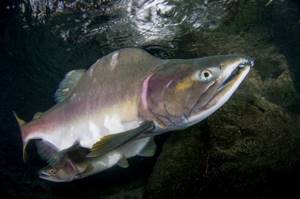
Pink salmon live in cold water. The optimal water temperature for growth and development is from 5 degrees to 15 Celsius. The fish does not swim into warm waters, since water temperatures above 20 degrees Celsius are lethal for them.
The required temperature corresponds to the waters of the Pacific and Arctic Oceans. Pink salmon is found from California to Kamchatka, the Kuril Islands, Sakhalin and the Japanese archipelago. A lot of fish live in the Chukchi Sea. Spawning grounds on the territory of Russia are the following rivers: Lena, Amur, Anadyr, Yana, Kolyma. Outside Russia, it spawns in the Mackenzie River, Amguem River, as well as in the rivers of Sweden, Norway and Finland.
Chemical composition, calorie content
More than 10 vitamins were found in pink salmon. The amount of these elements in 100 g of product:
- thiamine (B1) - 0.2 mg;
- riboflavin (B2) - 0.16 mg;
- choline (B4) - 94.6 mg;
- pantothenic acid (B5) - 0.75 mg;
- pyridoxine (B6) - 0.6 mg;
- folates (B9) - 7 mcg;
- cobalamin (B12) - 4.15 mcg;
- vitamin A - 30 mcg;
- ascorbic acid - 0.9 mg;
- calciferol (D) - 1.9 mcg;
- alpha tocopherol (E) - 1.5 mg;
- phylloquinone (K) - 0.4 μg;
- vitamin PP - 8.1 mg.
Pink salmon contains essential and essential amino acids, omega-3, omega-6, omega-9 fatty acids. Product studies have shown that 100 grams of fillet contains:
- potassium - 335 mg;
- phosphorus - 200 mg;
- sulfur - 190 mg;
- chlorine - 165 mg;
- sodium - 70 mg;
- magnesium - 30 mg;
- calcium - 20 mg;
- zinc - 0.7 mg;
- iron - 0.6 mg;
- fluorine - 0.43 mg;
- copper - 0.11 mg;
- chromium - 55 mcg;
- iodine - 50 mcg;
- manganese - 50 mcg;
- selenium - 45 mcg;
- cobalt - 20 mcg;
- nickel - 6 mcg;
- molybdenum - 4 mcg.
Calorie content of 100 g of raw pink salmon is 140 kcal. The amount of proteins is 20.5%, fats are 6.5–7%, carbohydrates are 0.
Calorie table for different cooking methods
| Cooking method | Kcal per 100 g |
| Cooking | 168 |
| For a couple | 145 |
| Baking | 150 |
| Frying with oil | 281 |
| Grilling | 147 |
| Salting | 169 |
| Smoking | 174 |
| Canning | 140 |
| Drying | 181 |
| Milk | 90 |
| Caviar | 230 |
Differences between pink salmon and other fish
A similar list of micro and macroelements was found in sea and river fish. But due to dietary habits, the concentration of nutrients may differ. Examples:
- Chum salmon. Less caloric, inferior in protein content, vitamins A, C, D, choline. Pink salmon is healthier for diabetics.
- Salmon. More caloric - 200 kcal per 100 g. Inferior to pink salmon in the concentration of calcium and manganese, but superior in the amount of omega-3 fatty acids, potassium, and protein. Salmon is less beneficial for bones, but has a faster effect on the heart and nervous system.
- Trout. Contains fewer calories - 90-97 per 100 g, more potassium, calcium, phosphorus. Effective on bone tissue. It is inferior in terms of influence on the organ of vision and ability to relieve inflammation, since pink salmon is more saturated with vitamin A and fatty acids.
- Mackerel. More caloric - 191 kcal per 100 g. Contains more vitamins B5, B6, B9, B12, C, D, sodium, calcium, fluorine, but it has a lower concentration of potassium, iodine, manganese, vitamin B1, protein. Mackerel is not a red fish.
- Loach. Less fatty – up to 6%. Inferior to pink salmon in the amount of vitamins, potassium, iron, iodine. Contains more calcium, magnesium, phosphorus. Pink salmon quickly helps improve hormonal levels, but char is more effective in the fight against osteoporosis.
- Saira. It has a light pink flesh color. Less rich in vitamins, higher in calories - 205 kcal, contains more fat.
- Coho salmon or Far Eastern salmon. It is superior to pink salmon in the concentration of choline, pantothenic acid, folate, potassium, sulfur, but inferior in the amount of calcium and magnesium.
Representatives of the salmon family
Chum salmon and pink salmon are the most common fish of the salmon genus. They make up more than eighty percent of the catch of fish of this species:
- Chum salmon is a type of Pacific salmon. There are two types of fish of this breed: summer and autumn. The first lives in the northern part of the world, the second in the south. Autumn chum salmon are much larger than summer ones. This fish has a highly developed sense of homeland - it always returns to spawn in the same place where it was born.
- Pink salmon is also called pink salmon. She prefers cold waters with a temperature no higher than 15 degrees - at 26 degrees the fish dies. Pink salmon eat high-calorie foods, and their meat is rich and fatty. It is superior to keta meat in terms of caloric content and amount of fat. Pink salmon spawn one and a half years after birth and usually die after spawning. For breeding, she chooses new places - usually rivers with large pebbles. The fry hide in a burrow for some time after birth, then are carried out to the open sea by the current.
Pink salmon and chum salmon differ both in appearance and habitat
.
The difference between the fillets of these fish is small. It can often be found on store shelves. Externally, the fish are also similar, but they have many differences:
Unscrupulous sellers often deceive people who do not know how chum salmon differs from pink salmon.
Chum salmon lives, inhabits and reproduces only in natural conditions. Its meat is especially valuable, as it is grown without growth stimulants and antibiotics. Fish are found both in fresh waters and in seas and oceans. Among salmonids it is especially widespread.
Chum salmon does not have a specific habitat
. Large schools of fish enter rivers to spawn, and young fish leave the rivers for the oceans. During travel to the spawning grounds, its color changes: the fish becomes darker, stripes appear on its body. Its massive and long tail is designed to dig holes for eggs. Sometimes the depth of the pits reaches two meters. In Russia, chum salmon catches are small, which leads to a fairly high price for its meat.
Pink salmon are found in fresh and marine waters of the northern hemisphere. Most often it can be found off the Pacific coast and in the Arctic. Fish constantly migrate from ocean waters to rivers and back, covering vast distances.
Pink salmon begin and end their lives in rivers. Fish spawning occurs in July-September. The fry remain in the rivers until summer, then they are sent on a journey to the ocean, where they live until they reach marriageable age. The fish then return back to the rivers. There they give birth to offspring and die during spawning
.
Pink salmon that live in the ocean have a bluish or blue-green back, silvery sides and a white belly. When returning to fresh waters, the fish becomes pale gray behind, its abdomen acquires a yellowish or green tint.
Buyers often argue about which is tastier - chum salmon or pink salmon. Meanwhile, the meat of both fish is tasty and healthy. It belongs to the fatty varieties and contains a large amount of microelements, vitamins and fatty acids.
Pink salmon has a fattier and higher-calorie fillet. This is due to the fact that it lives in cold waters and eats high-calorie foods. Its meat has a dense consistency and pale pink color. Its calorie content is 145−147 kcal
.
Chum salmon meat is drier and less fatty. It is considered a valuable dietary product as it contains fewer calories. The energy value of tender fillet is 125 kcal. It looks bright pink. Meat contains more vitamins, especially group B, including B5, B6, B9, B12. Pink salmon meat has the best mineral composition: it contains a lot of iodine, manganese, chromium, cobalt, and fluorine.
Chum salmon and pink salmon caviar differ in appearance and composition. In chum salmon it is larger and has a bright red-orange color. Pink salmon caviar is smaller in diameter. It is covered with a dense outer shell. The caviar of both fish has excellent taste, but chum salmon contains more protein, which is completely absorbed by the human body. It also contains more minerals and vitamins. Although there is no dispute about tastes, chum salmon caviar and meat are considered more tasty and healthier than pink salmon.
Sometimes they ask which is better - salmon or chum salmon
. But any fish from the salmon family is called salmon. Therefore, it is incorrect to talk about the difference between salmon and chum salmon, since chum salmon is the same salmon.
We can talk a lot about the benefits of fish dishes. Pink salmon can be considered one of the most valuable commercial fish in this regard: it is quite affordable and is sold almost everywhere, and is very useful due to its high content of vitamins, microelements, unsaturated fatty acids and proteins. Pink salmon is often called salmon. Are these names interchangeable? Or are pink salmon and salmon different types of fish and should not be identified? In the article you will find all the answers to the questions that have arisen on this topic.
Benefits and harms in diseases
Natural pink salmon can ease the course and speed up the elimination of pathology. But you should take into account the rules for eating fish.
Features of the product's influence:
- Gout. Pink salmon helps prevent joint inflammation and replenish the lack of useful elements. However, fish contains purines, so it can be consumed once a week, 150 g.
- Pancreatitis. Pink salmon accelerates the restoration of the mucous membrane and prevents pain. Eat fish 1-2 times a week, 100-150 g each. In case of exacerbation, you should discard the product.
- Diabetes. Fish dishes prevent increases in cholesterol and blood sugar levels. It is useful to consume pink salmon 2 times a week, 150 g each.
- Gastritis. In case of pathology, fish helps to normalize the condition of the mucous membrane and regulate the functioning of the stomach and intestines. It is allowed to eat pink salmon 3 times a week, 100 g each. The daily norm is divided into 2 doses: for gastritis, eat food often and in small portions.
- Cholecystitis. If the gallbladder is inflamed, you can eat fish once a week. The product is needed to maintain supplies of vitamins and minerals and prevent the spread of infection. But frequent use provokes the formation of sediment and stones in the gall bladder.
- Oncology. Fish allows you to maintain strength without putting a strain on your digestion. The product helps prevent the formation of cancer cells, but if you have the disease, its use should be limited to 4 times a month. Pink salmon must be combined with fresh salads.
Regardless of the disease, fish should be baked, boiled, or steamed. Salted, smoked, canned and fried in oil should be avoided. Details will be revealed in the paragraphs below.
Benefits of eating caviar, liver, milk
Product Features:
- Pink salmon caviar. Higher in calories than fillet, contains more protein, but less fat. The product is superior to meat in terms of the amount of vitamins, macro and microelements. Caviar brings the greatest benefit to the visual organs, skin, and hair. Use salted.
- Liver is a delicate, soft product. The calorie content is approximately equal to fillet, but contains less fat, more iron, and B vitamins. The liver is more effective in eliminating anemia, depression, and lowering cholesterol levels. The product can be fried in batter, but it is healthier when baked in foil.
- Milk is low-calorie and easier to digest by the body than caviar. They contain 6 times more vitamin B12 and calcium, 4.5 times more iron than meat. The by-product improves hematopoietic functions, eliminates insomnia, and helps prevent prostatitis. Milk can be salted and smoked; it is healthier to bake or boil it.
Harm of canned pink salmon
Canned pink salmon is a tasty and affordable product. In stores you can see fish in jars from Dobroflot, 5 Seas and other manufacturers from different countries. The dish is nutritious, suitable for sandwiches, salads and soups.
But there are also disadvantages to such a product. During heat treatment, only a portion of the vitamins and complex compounds are preserved; a large portion disintegrates due to prolonged heating.
Canned food can be harmful to the body.
Causes:
- During prolonged storage in metal containers, oxidative processes are activated. Modified substances settle in the kidneys and destroy liver cells.
- When making canned food, a large amount of spices and salt are used. Additives irritate the mucous membranes and cause fluid retention in the body.
- Canned pink salmon with added oil leads to obesity, accumulation of bad cholesterol, and blockage of blood vessels.
If you deviate from the manufacturing rules, bacteria may enter the jar, causing the development of botulism. The danger of canned food to humans increases with shelf life.
Freshly prepared pink salmon is healthier. Canned fish is “dead” food that can disrupt digestion and cause poisoning.
Pink salmon lifestyle
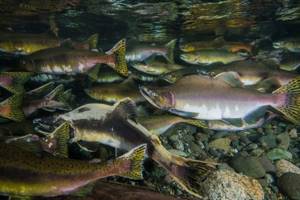
The lifestyle of pink salmon is similar to many representatives of the Pacific salmon family, with the difference that after spawning the fish dies. Since this fish is migratory, it is not tied to one habitat. The fish is born in the upper reaches of fresh rivers, and spends most of its life in the cool salty water of the seas, and only returns to spawn. The life of pink salmon is short and lasts about two years. Her whole life revolves around procreation, this is her mission. In the seas, fish are actively feeding. She eats actively and gains weight. The fish menu is very nutritious and high in calories. Prefers small fish and crustaceans. The latter occupy a priority place in the diet. All this is preparation for the only migration in the world for the sake of procreation.
Most salmon have a natural navigator that unmistakably leads them to the spawning site. In pink salmon, it is poorly developed, and therefore the fish are often carried into places completely unsuitable for spawning.
Is there any benefit to smoked, salted pink salmon?
Hot and cold smoked fish are popular. The product is delicate, attractive with aroma and color, and does not fall apart when divided into pieces. It can be consumed separately, become part of salads, sandwiches, or complement side dishes of porridge and potatoes. But the product is harmful because during the cooking process it accumulates carcinogens that cause the formation of cancer cells.
Salted pink salmon is not heat-treated, so the amount of nutrients in the finished dish is preserved. Fish is good for humans, but when consumed in moderation. It is safe to eat 100 g of product per day, 2 times a week. When the norm increases, pink salmon provokes urinary retention and swelling, increased blood pressure, and the formation of kidney stones.
Dried and dried fish have the same qualities as salted fish. But during the cooking process, pink salmon loses moisture and becomes lighter. 100 g of product contains more calories and salt. You can eat this fish once a week.
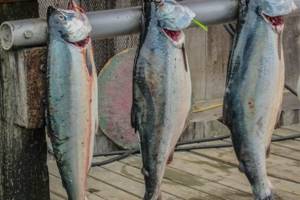
How to cook pink salmon at home: recipes
The two simplest recipes for preparing this fish are baking and salting.
In the oven
To prepare the dish you will need:
- pink salmon carcass (fresh, chilled or frozen);
- 1 lemon;
- onions - one large onion or two medium ones;
- one processed cheese;
- 3 tablespoons of mayonnaise;
- 1 chicken egg;
- salt, pepper - to taste.
Procedure:
- Disassemble the fish. Remove the head, fins, entrails, spine and small bones. Divide the carcass into two halves, and each into portioned pieces.
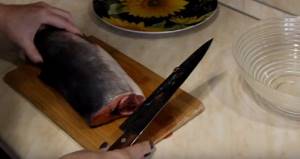
- Place the fish, skin side down, on a baking sheet lined with foil. First, the foil should be greased with vegetable oil so that the fish does not stick.
- Salt the meat and sprinkle with freshly ground pepper.
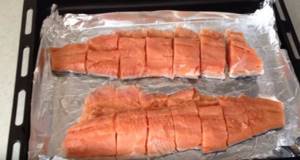
- Squeeze the juice from the lemon and pour it generously over the fillets.
- Let the fish marinate, leaving it to stand at room temperature for 20 minutes.
- Meanwhile, peel the onion, cut into half rings and fry in vegetable oil until transparent (if desired, you can simmer the onion a little longer until golden brown).
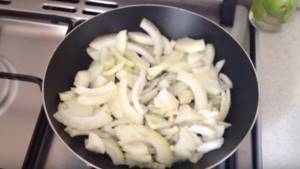
- Grate the cheese on a coarse grater.
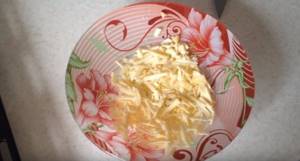
- Add mayonnaise and a raw chicken egg to the cheese. Mix the resulting dressing thoroughly.
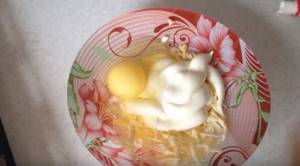
- Place the fried onion on the fish, distributing it evenly throughout the carcass.
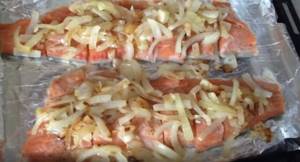
- Top the carcass with cheese and egg dressing.
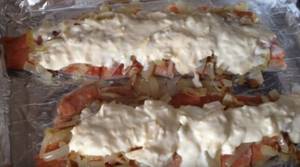
- Bake pink salmon “under a fur coat” in an oven preheated to 180°C for 35 minutes.

- Place fish on plates in portions. If desired, you can decorate the dish with a slice of lemon and fresh herbs.
This dish can be eaten without a side dish, since it is very filling and high in calories, but if desired, its taste will be wonderfully enhanced by boiled rice or potatoes.
Video: delicious baked pink salmon
How to choose pink salmon in the store
Salmon are sold frozen and chilled. Selection principles:
- Prefer chilled pink salmon.
- It is better to purchase fish that have not been gutted. In places of cuts, the product becomes weathered. These parts become bitter and will have to be cut off.
- Choose a medium-sized carcass. The larger the pink salmon, the greater the likelihood that it was caught already dead: the fish dies after spawning. It is before the end of life that waterfowl gain maximum weight.
- Check the color of the gills. In fresh pink salmon they are dark red. The presence of a gray or green coating indicates that the product has begun to deteriorate.
- Buy smooth carcasses without cuts or creases with clear eyes. The rule applies to both frozen and chilled specimens.
- Pay attention to the tightness of the skin to the meat. If the skin comes off, the product is spoiled.
- When buying a chilled carcass, press it with your finger. On fresh fish, dents are smoothed out immediately.
How to fillet pink salmon without bones
- Using a sharp knife, remove the scales from the carcass. You need to move from the tail to the head.
- We wash the pink salmon with cold water and cut off the fins with kitchen scissors.
- To remove the head, insert a knife below the gills and make oblique cuts towards the back.
- We immerse the cutting tool shallowly into the abdomen and move it from the anal fin to the head.
- We take out the insides, peel off the dark film, and rinse the carcass again with cold water.
- We trim the carcass along the ridge, remove the top layer of fillet, and release the remaining part of the meat.
- We pry up the remaining bones with a knife and remove them. During the procedure, we try not to grab the meat.
Pink salmon is easier to separate from the bones if you freeze it a little before cutting. Also, the skin comes off better from hard fish.
Pink salmon spawning
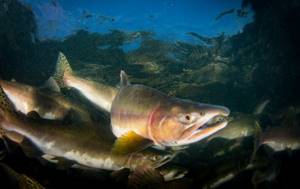
Since pink salmon is an anadromous fish, it travels thousands of kilometers up rivers to spawn. Like Chinook salmon, the fish die after spawning. This is due to the total restructuring of the body and the energy expended. The fish spends too much energy during spawning and stops feeding. There is not enough vitality to go down to the sea. The fish goes to spawn in the same place where it emerged from the eggs several years ago. The appearance of the females practically does not change, while the males wear a “nuptial” outfit. In rivers, males predominate over females.
Spawning begins in July and continues until October. The entry of fish into the river begins in June, when the water warms up. Rising against the current, the fish moves upward to the spawning site.
The female makes nests in the ground. Powerful blows of the tail are made at the bottom of the depression, where the eggs will subsequently be thrown. After the males fertilize the eggs, they will be buried. One female lays from 1000 to 2500 thousand eggs. Over the next 2-3 months, the eggs will hatch into larvae. They will spend the entire winter in the hole, feeding on the yolk sac. After wintering, the three-centimeter fry will leave the nest and begin their journey to the sea. Unfortunately, most of the fry will not go down to the sea and will be eaten by predators.
